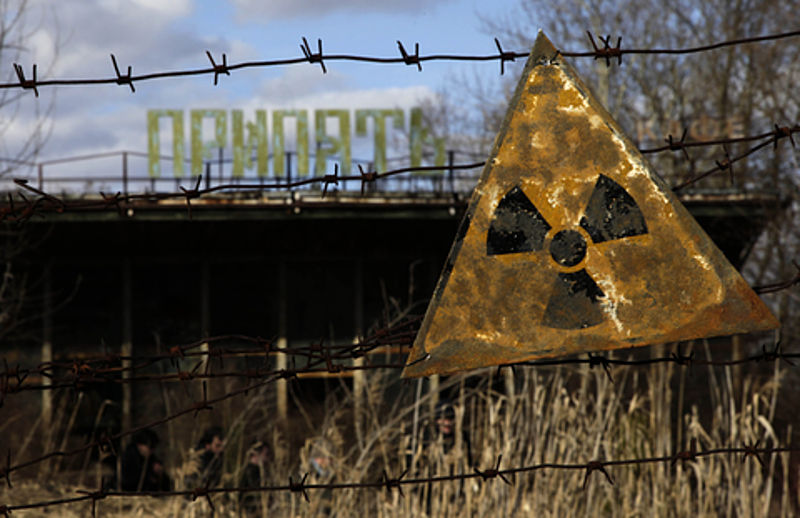by Tatyana Ivanova
The thirtieth anniversary of the accident at the Chernobyl nuclear power plant took place at the end of last month. Considered the radiation disaster of the century because of its size and long-term consequences, Chernobyl has affected hundreds of thousands of people and will continue to have a dangerous impact on generations to come.
Chernobyl’s biologically active radionuclides will decay to insignificant amounts after 10 half-lives. For strontium-90, this amounts to about 290 years, for cesium-129 some 300 years. Some of the highly toxic and carcinogenic radionuclides will take an eternity to degrade. The half-life of uranium-238 is about 4.5 billion years, of plutonium-239 some 24,000 years, and of iodine-129 about 15 million years.
The authors of a study at Dartmouth College point out that iodine-129 is perpetually accumulating in the environment and poses a growing radiological risk due to its long half-life. Chernobyl released a significant amount of radioactive iodine, including I-129, into the atmosphere.
According to Alexey Yablokov, an academician of the Russian Academy of Science, some of the toxic radionuclides decay to radioactive hazardous elements. Of particular concern, plutonium-241 produces americium-241, both similar in toxicity and effects on the human body. The Ministry of Emergency Situations in Belarus reports that the radioactive contamination by Americium-241 is growing, and in the next 100 years its amount will double.
Belarus has been the country most affected by the Chernobyl radiation disaster. According to the Ministry of Emergency Situations, 66% of the country’s territory was contaminated by cesium-137 and 10% by strontium-90. The entire Belarusian population suffered from iodine’s impact. According to the National Statistical Committee of the Republic of Belarus about 1.1 million of inhabitants, or 12% of the country’s population, continue to live in areas contaminated by the Chernobyl catastrophe. According to a 2016 Greenpeace report, people in contaminated areas are affected by hazardous radiation exposure, both external and internal by way of food and water.
Political Consequences
Chernobyl was the first precipitating factor in Belarus’ break with the Soviet Union. During the immediate fallout of 1986, the Soviet regime kept quiet about it, forcing workers and students to go out for the annual May Day parade and exposing them to radioactive iodine releases just to “prevent panic.” Citizens learned the truth about Chernobyl only from Western media.
Despite the fact that Soviet authorities paid a very high price for their criminal deception about Chernobyl, the dictatorship in Belarus continues to conceal the truth about the impact of Chernobyl on public health. It does not disclose the basic information about contamination, and it carefully masks the connection between Chernobyl and morbidity. Today, according to the official propaganda line, Belarus is almost free of contamination from strontium-90 and cesium-137. At the same time, the Belarusian government is actively developing contaminated lands to grow food.
In January 2016, the government removed 203 communities from the list of contaminated areas, cutting off the associated welfare benefits to a total population of about 31,000 people.
The Belarusian state has called for extending economic activity into polluted territories. To prevent the unacceptable exposure of workers during harvesting, the state has proposed this year to distribute “additional worker coveralls,” which, as a rule, are just cotton jumpsuits. The cultivation of radioactive potatoes and other root vegetables will be expanded. According to the program, the contamination will be reduced with the use of chemical fertilizers and state radiation control.
On the eve of Chernobyl’s 30th anniversary, journalists from the Associated Press found radioactive milk at a dairy farm in a Belarusian village about 45 kilometers from the Chernobyl reactor. The level of radionuclides was 10 times higher than the permissible limits. However, the Belarusian Ministry of Extraordinary Situations (MCHS) has denied these allegations, claiming that all the milk from the highly contaminated areas is under strict radiation control and all the amounts are below limits.
According to an MCHS representative who spoke at the European Parliament in early April, Belarus “successfully exports food from contaminated lands, in particular, to the U.S.A.”
Belarusian President Alexander Lukashenko has declared that Belarus is successfully outgrowing the stigma of Chernobyl. Lukashenko has been angling for international financial support for “sustainable development” of the radioactive areas. On April 25, the day before the thirtieth anniversary, he accepted UN Development Program financing for this development.
At the same time, experts have argued that it would be safer to resettle people than to spend the $1.3 billion that the Belarus government plans to spend on improving the quality of life on contaminated land between 2016 and 2020. In an April 25 interview, for instance, Alexei Yablokov recommended resettlement and a cessation of all agricultural production to save human lives and money.
Yury Voronezhtsev, secretary of the Soviet commission on the investigation of the causes of Chernobyl accident, said back in 1990 that the state should resettle all the people from the polluted lands because life there was unsafe at best. A resident of contaminated Gomel, Voronezhtsev said that official policy has already led to irresponsible behavior on the part of inhabitants of the polluted lands: they consume the berries and mushrooms collected in the radioactive forests, as well as the milk and meat grown on the radioactive land. They also sell these goods at seasonal markets, contributing to the spread of hazardous radionuclides.
Commemorating Chernobyl
During the anniversary commemoration of Chernobyl victims in Belarus, NGOs, Greens, and political opposition representatives described all of these problems as a “political Chernobyl.” These activists are concerned not only about the past radiation catastrophe but a future one as well, connected to the current nuclear power plant construction in Belarus.
About 2,000 participants in this year’s annual street rally, with permission from the authorities, demonstrated against Chernobyl’s poisoning of Belarusians and supported the call of the Belarus Antinuclear Campaign, the NGO Ecohome, and the Belarusian Greens to stop nuclear power plant construction in what remains one of the few uncontaminated parts of the country. In a recent interview, an Ecohome representative said that the government is violating a large number of technical norms—for instance, proceeding without a project design—in order to build the nuclear plant.
Nobel Prize winner Svetlana Alexievich, the Belarusian writer, has also supported the anti-nuclear campaign. In her speech in Lithuania on April 30, she characterized nuclear power plant construction as a crime against Belarusians.
Recently, the well-known German politician and head of the Green fraction in the European Parliament Rebecca Harms said in an interview that Chernobyl played an important role in pushing Germany away from nuclear power and toward renewable energy. “When we talk about the German experience, we have to state that the economy of renewable energy is much better than that of nuclear energy,” she added. This is a fitting way to remember Chernobyl 30 years later, by embracing sustainable energy production. Covering up its destructive legacy, meanwhile, will only lead to a repeat of the same mistakes, such as building another generation of faulty reactors.
Tatyana Ivanova is a Belarusian journalist residing in the United States.





